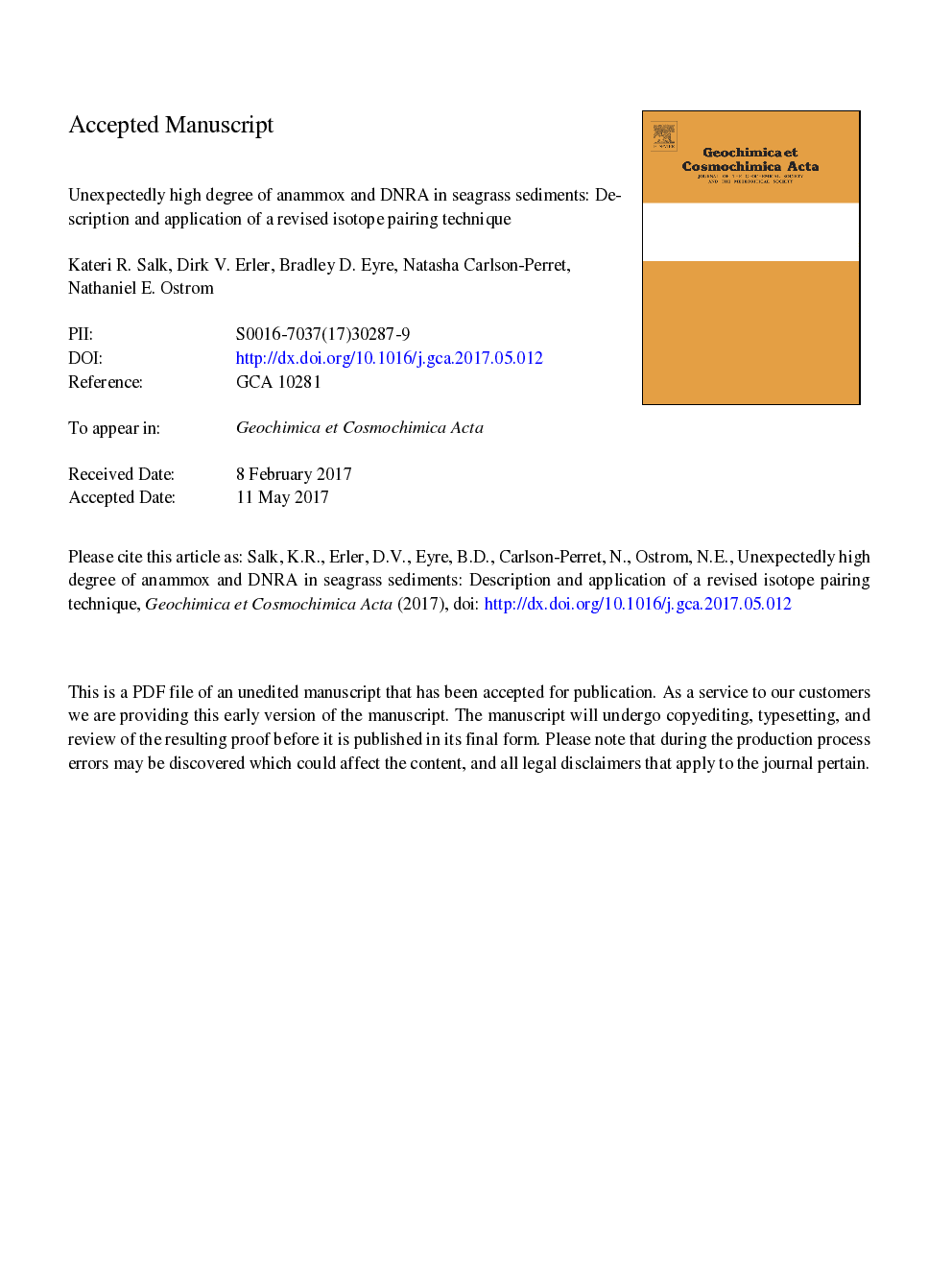| کد مقاله | کد نشریه | سال انتشار | مقاله انگلیسی | نسخه تمام متن |
|---|---|---|---|---|
| 5783387 | 1637946 | 2017 | 47 صفحه PDF | دانلود رایگان |
عنوان انگلیسی مقاله ISI
Unexpectedly high degree of anammox and DNRA in seagrass sediments: Description and application of a revised isotope pairing technique
دانلود مقاله + سفارش ترجمه
دانلود مقاله ISI انگلیسی
رایگان برای ایرانیان
موضوعات مرتبط
مهندسی و علوم پایه
علوم زمین و سیارات
ژئوشیمی و پترولوژی
پیش نمایش صفحه اول مقاله

چکیده انگلیسی
Understanding the magnitude of nitrogen (N) loss and recycling pathways is crucial for coastal N management efforts. However, quantification of denitrification and anammox by a widely-used method, the isotope pairing technique, is challenged when dissimilatory NO3â reduction to NH4+ (DNRA) occurs. In this study, we describe a revised isotope pairing technique that accounts for the influence of DNRA on NO3â reduction (R-IPT-DNRA). The new calculation procedure improves on previous techniques by (1) accounting for N2O production, (2) distinguishing canonical anammox from coupled DNRA-anammox, and (3) including the production of 30N2 by anammox in the quantification of DNRA. This approach avoids the potential for substantial underestimates of anammox rates and overestimates of denitrification rates in systems where DNRA is a significant NO3â reduction pathway. We apply this technique to simultaneously quantify rates of anammox, denitrification, and DNRA in intact sediments adjacent to a seagrass bed in subtropical Australia. The effect of organic carbon lability on NO3â reduction was also addressed by adding detrital sources with differing C:N (phytoplankton- or seagrass-derived). DNRA was the predominant pathway, contributing 49-74% of total NO3â reduction (mean 0.42 µmol N mâ2 hâ1). In this high C:N system, DNRA outcompetes denitrification for NO3â, functioning to recycle rather than remove N. Anammox exceeded denitrification (mean 0.18 and 0.04 µmol N mâ2 hâ1, respectively) and accounted for 64-86% of N loss, a rare high percentage in shallow coastal environments. Owing to low denitrification activity, N2O production was â¼100-fold lower than in other coastal sediments (mean 7.7 nmol N mâ2 hâ1). All NO3â reduction pathways were stimulated by seagrass detritus but not by phytoplankton detritus, suggesting this microbial community is adapted to process organic matter that is typically encountered. The R-IPT-DNRA is widely applicable in other environments where the characterization of co-existing NO3â reduction pathways is desirable.
ناشر
Database: Elsevier - ScienceDirect (ساینس دایرکت)
Journal: Geochimica et Cosmochimica Acta - Volume 211, 15 August 2017, Pages 64-78
Journal: Geochimica et Cosmochimica Acta - Volume 211, 15 August 2017, Pages 64-78
نویسندگان
Kateri R. Salk, Dirk V. Erler, Bradley D. Eyre, Natasha Carlson-Perret, Nathaniel E. Ostrom,